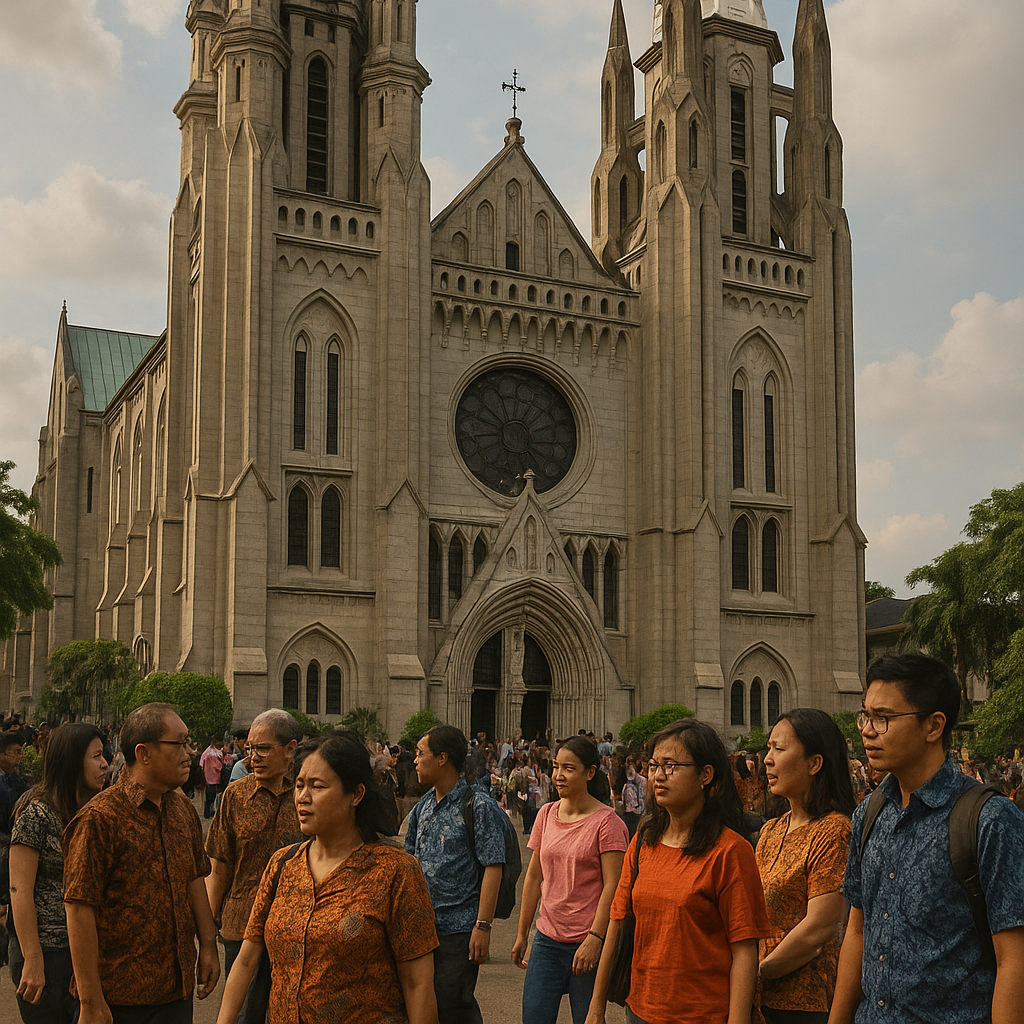The History and Dynamics of Christianity in Luhu, Maluku: From the Initial Mission to Contemporary Acculturation
theolingua.id – Luhu is a village located in West Seram Regency, Maluku Province. Geographically, Luhu is on the west coast of Seram Island, which is known as one of the largest islands in the Maluku Islands. This region has a diverse landscape, consisting of beaches, tropical forests, and mountains, which are part of the typical Maluku ecosystem. Luhu is also in a strategic area, close to the sea trade routes that have existed since the colonial era, making it one of the centres of social and cultural interaction in the Seram region.
Demographically, the Luhu community has a distinctive ethnic and cultural diversity. The majority of the population comes from indigenous Maluku tribes with strong customs and a social system that still maintains local wisdom. In addition, outside influences, especially from Europeans since the 16th century, have shaped the social dynamics in this region, including in the religious aspect. Christianity and Islam are the two main religions embraced by the Luhu community, with a long historical trail in their development.
Culturally, Luhu has a rich tradition, including in the fields of art, music, and traditional rituals. Some traditional ceremonies are still preserved today as part of the community’s identity. In addition, kinship systems and social structures based on custom still play an important role in everyday life. The acculturation of religion and local culture is a characteristic that shapes the identity of the Luhu community, where Christian values are often combined with local traditions.
As one of the areas that is part of the history of the spread of Christianity in Maluku, Luhu has an important role in understanding how the process of Christianisation occurred in eastern Indonesia. By tracing its historical footprints, we can reveal how Christianity entered, developed, and faced challenges in various periods, from the colonial era, post-independence, to the modern era.
By understanding this history, we can see how Christianity not only functions as a belief system, but also as an element that shapes social and cultural dynamics in Luhu. The dynamics of Christianity in Luhu cannot be separated from local culture and social interactions that occur in society. Since the entry of Christianity, there have been various forms of adaptation and acculturation with local traditions.
Some traditional rituals have been adapted to Christian values, while symbols of local culture have persisted in religious practices. This shows that the development of Christianity in Luhu is not merely the result of a religious mission, but also part of a broader social process. In addition, the interaction between Christianity and other religions, especially Islam, is also an important aspect of social dynamics in Luhu. As an area with religious diversity, relations between religious communities are a crucial factor in maintaining social harmony.
The History and Development of Christianity Over Time in Luhu
The entry of Christianity into Luhu, Maluku, is inseparable from the history of the spread of Christianity in the Maluku Islands as a whole. Maluku is known as one of the first regions in the archipelago to accept Christianity, especially after the arrival of Europeans in the 16th century. The arrival of the Portuguese in Maluku around 1512 brought with them missionaries who sought to spread Christianity, especially Catholicism, among the local population.
However, the spread of Christianity in Luhu itself is more closely associated with the arrival of the Dutch through the VOC (Vereenigde Oost-Indische Compagnie) in the early 17th century. The VOC brought Protestant missionaries who sought to Christianise the local population as part of their political and economic policies in the Maluku region. One of the factors that encouraged the spread of Christianity in Luhu was the close trade relationship with Europe, which influenced the culture and belief system of the local community.
In the early days of its spread, Christianity was gradually accepted by the Luhu community, mainly through the education introduced by missionaries. The establishment of the first church in Luhu marked the beginning of the formation of a Christian community that grew from generation to generation. In addition, several local figures played a role in supporting the spread of Christianity, both by translating the scriptures into the local language and by bridging the understanding between local traditions and Christian teachings.
Since the introduction of Christianity to Luhu, its development has undergone various dynamics influenced by political, social, and cultural factors. During the Dutch colonial period, Christianity developed rapidly through the education system and churches introduced by Protestant missionaries. The church functioned not only as a place of worship but also as a centre for education and social administration.
At the beginning of the 20th century, with the increasing awareness of nationalism, the role of the church in the social life of the Luhu community became increasingly visible. Apart from being a place for spiritual development, the church also provided a forum for the community to obtain modern education and knowledge. Several mission schools were established to educate local children, who later played a role in shaping the Christian intellectual elite in Maluku.
After Indonesian independence, the development of Christianity in Luhu continued with more and more churches and Christian organisations contributing to education, health and social services. The church began to play a more independent role in organising its religious activities, no longer relying entirely on foreign missionaries.
In the modern era, Christianity in Luhu faces various challenges, such as globalisation, social change, and interaction with other religions and cultures. However, Christian values remain an integral part of the identity of the Luhu community. Acculturation between Christian teachings and local culture continues to occur, as seen in how some traditional customs are still maintained in daily religious practices.
Today, Christianity in Luhu not only survives but also thrives with various religious, educational, and social activities managed by the local church and Christian community. Interfaith relations in Luhu are also a concern, with the community striving to maintain harmony between the Christian and Muslim communities that have coexisted for centuries.
By understanding the development of Christianity over time in Luhu, we can see how this teaching has been transformed from a mere belief brought by missionaries into part of the social and cultural identity of the local community.
The Spread and Interaction of Christianity with Other Cultures and Religions in Luhu
The spread and development of Christianity in Luhu has not always been smooth. Since it was first introduced, this religion has faced various challenges stemming from social, cultural, and political factors. One of the main obstacles in the early spread of Christianity was the resistance from community groups who still held fast to their traditional beliefs. For some Luhu people, Christian teachings were considered to be contrary to the ancestral belief system that had been passed down from generation to generation. Therefore, there was resistance in accepting this new teaching, especially during the early days of the missionaries’ arrival.
In addition, the influence of Islam, which first entered the Maluku region, also posed a challenge to the spread of Christianity. In several periods of history, there was tension between the Christian and Muslim communities, especially amid colonial political dynamics that often exploited religious differences as a tool of power. VOC policies that favoured the Christian group often triggered tensions with the Muslim community, creating social barriers in Luhu society.
Another obstacle was the limited manpower and resources available to build religious infrastructure such as churches and mission schools. During the colonial period, the spread of Christianity depended heavily on the presence of a limited number of European missionaries. After Indonesia’s independence, new obstacles emerged in the form of the local church’s adaptation to social, economic, and political changes. Some churches had difficulty in managing their congregations, especially with the modernisation and influence of globalisation, which brought about changes in people’s mindsets.
In the modern era, another challenge faced is the emergence of secularisation and a shift in traditional values due to technological developments and urbanisation. The younger generation in Luhu is beginning to be exposed to a global culture that sometimes conflicts with religious values. The church needs to face this challenge with a more adaptive strategy in order to remain relevant in the life of the Luhu community.
Christianity in Luhu does not develop in an isolated space, but experiences various forms of interaction with local culture and other religions, especially Islam. Since the beginning of its spread, Christianity has undergone a process of acculturation with local traditions. Some elements of local culture are still preserved in religious practices, such as in the form of traditional ceremonies that are harmonised with Christian teachings.
One example of this acculturation can be seen in the way the Luhu community combines Christian values with their traditional customs, such as in the celebration of religious holidays which are often accompanied by Malukan dance, music, and rituals. In addition, the concept of kinship and a social system based on traditional values still survive in the Christian community in Luhu, reflecting how religion and culture can adapt to each other.
The interaction between Christianity and Islam in Luhu also shows an interesting dynamic. Despite their different beliefs, the Christian and Muslim communities in Luhu have long lived side by side. In everyday life, they often work together in various aspects, such as in the economic, educational, and social spheres. In some traditional celebrations and community activities, both Christians and Muslims can participate together, showing strong tolerance and social cohesion.
However, history also records periods of tension between religious communities in Maluku, including in Luhu, especially in the context of the social and political conflicts that occurred at the end of the 20th century. However, efforts at reconciliation and interfaith dialogue continue to rebuild social harmony. Today, interaction between Christianity and Islam in Luhu is more oriented towards cooperation and tolerance, with various initiatives aimed at strengthening relations between religious communities.
Overall, the development of Christianity in Luhu is not only influenced by internal factors within the Christian community itself, but also by dynamic interactions with local cultures and other religions. The acculturation of culture and the evolving interfaith relationship show that Christianity in Luhu is not just a historical legacy, but also part of a social life that continues to adapt to changing times.
Acculturation of Christianity in Luhu Community Life
The acculturation of Christianity in Luhu society has not only taken place in the past but continues to evolve to this day. This process reflects how Christian values can coexist with local culture, creating unique traditions that are still upheld by the community. This acculturation is seen in various aspects of life, from religious rituals, art and culture, to social norms that are still upheld by the Christian community in Luhu.
One form of acculturation that still survives is the celebration of Christian holidays combined with elements of the local culture. For example, during the Christmas and Easter celebrations, the Luhu community often holds events that are not only religious but also have traditional elements, such as traditional dances, traditional Maluku music, and traditional dishes that are part of the celebrations. This shows how the community maintains their cultural identity while practising Christianity.
In addition, wedding processions in the Christian community in Luhu also retain traditional elements. Although the wedding blessing is performed in the church, several traditional traditions are still carried out before or after the ecclesiastical procession, such as the ritual of blessing from traditional elders and a communal meal as a symbol of togetherness and brotherhood.
Ecclesiastical music and singing in Luhu also show the influence of local culture. In addition to using spiritual songs in Indonesian, congregations often sing adapted hymns in local languages with traditional musical instruments such as the tifa and totobuang. Church choirs in some areas also adopt a distinctive Maluku style of singing known for its unique vocal harmony, reflecting the fusion of religious values and local art and culture.
In social life, the Christian community in Luhu still upholds family values, which are also part of the local tradition. The concept of ‘pela gandong,’ which is a bond of brotherhood between communities of different religions and ethnicities, is maintained as a form of tolerance and togetherness. This value is in line with Christian teachings about love and brotherhood, thus becoming the basis for the community in maintaining harmonious social relations.
In addition, the strong value of mutual cooperation in the Christian community in Luhu also shows how Christian teachings are acculturated with the local culture. For example, in church construction or religious social activities, people work together regardless of social or economic differences. This shows that the spirit of togetherness that has been passed down from generation to generation is still relevant in everyday life.
Christian acculturation is also reflected in church architecture and religious symbols that adapt local cultural elements. Some churches in Luhu have a design that incorporates Maluku architectural elements, such as the use of local wood, local carvings, and ornaments that reflect a blend of Christian beliefs and traditional cultural values.
In addition, in some Christian homes, it is common to find carvings or motifs typical of Maluku integrated with Christian symbols such as the cross or images of Jesus. This shows that the community has retained their cultural elements without losing their religious identity.
The acculturation of Christianity in the life of the Luhu community today is proof that religion and culture can adapt to each other without cancelling each other out. The local tradition combined with Christian teachings not only enriches religious practices, but also strengthens the social identity of the community. Forms of acculturation such as religious celebrations combined with local culture, ecclesiastical music and art that adopt traditional elements, family values that are maintained, and church architecture that reflects local characteristics are clear examples of how acculturation remains relevant in the life of the Christian community in Luhu to this day.








